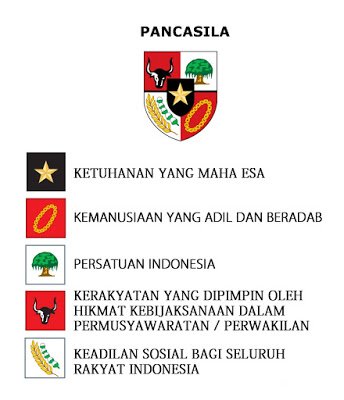The symbol of a star that has five angles symbolizes the first precepts of Pancasila, namely Belief in the One Supreme. The star represents a light, like the light emitted by God to every human being. The symbol of a star is also interpreted as a light to illuminate the five State Bases (Preamble to the 1945 Constitution) paragraph 4), the five State Character (the Preamble of the 1945 Constitution), and the state's fifth objective (Preamble to the Constitution '46 para. 4). While the black background indicates the color of nature and implies that the blessing of God's grace is the source of everything.
The chain represents the second precepts of Pancasila, the Just and Civilized Humanity. The chain consists of a chain-shaped rectangle and a circle that is interconnected in a circle. The rectangular chain represents the male, while the circle represents the female. A linked chain also symbolizes that every human being, man and woman, need each other and need to unite to become strong like a chain.
The banyan tree symbolizes the third precept, namely Persatuan Indonesia. The banyan tree represents a large tree that can be used by many as a shelter beneath it. It represents the State of Indonesia which is the shelter of all the people of Indonesia. The banyan tree also has tendrils and roots that radiate in all directions. This represents the diversity of ethnic groups that are united in Indonesia.
The head of the bull symbolizes the fourth precepts of Pancasila, which is Democracy Led by Wisdom of Wisdom in Representative Deliberation. The head of the bull symbolizes social animals that like to gather, as does deliberations where people have to gather to discuss something.
Rice and cotton symbolize the five principles of Pancasila, the Social Justice for All Indonesians. Rice and cotton can represent the fifth precept, because rice and cotton are the basic necessities of every human being, namely food and clothing, as the main condition for achieving prosperity. It corresponds to the main purpose of the fifth precept.
